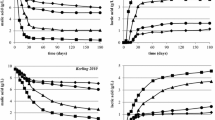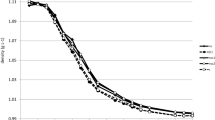Abstract
Malolactic fermentation (MLF) is an integral step in red winemaking, which in addition to deacidifying wine can also influence the composition of volatile fermentation-derived compounds with concomitant affects on wine sensory properties. Long-established winemaking protocols for MLF induction generally involve inoculation of bacteria starter cultures post alcoholic fermentation, however, more recently there has been a trend to introduce bacteria earlier in the fermentation process. For the first time, this study shows the impact of bacterial inoculation on wine quality parameters that define red wine, including wine colour and phenolics, and volatile fermentation-derived compounds. This study investigates the effects of inoculating Shiraz grape must with malolactic bacteria at various stages of alcoholic fermentation [beginning of alcoholic fermentation (co-inoculation, with yeast), mid-alcoholic fermentation, at pressing and post alcoholic fermentation] on the kinetics of MLF and wine chemical composition. Co-inoculation greatly reduced the overall fermentation time by up to 6 weeks, the rate of alcoholic fermentation was not affected by the presence of bacteria and the fermentation-derived wine volatiles profile was distinct from wines produced where bacteria were inoculated late or post alcoholic fermentation. An overall slight decrease in wine colour density observed following MLF was not influenced by the MLF inoculation regime. However, there were differences in anthocyanin and pigmented polymer composition, with co-inoculation exhibiting the most distinct profile. Differences in yeast and bacteria metabolism at various stages in fermentation are proposed as the drivers for differences in volatile chemical composition. This study demonstrates, with an in-depth analysis, that co-inoculation of yeast and bacteria in wine fermentation results in shorter total vinification time and produces sound wines, thus providing the opportunity to stabilise wines more rapidly than traditional inoculation regimes permit and thereby reducing potential for microbial spoilage.


Similar content being viewed by others
References
Alexandre H, Costello PJ, Remize F, Guzzo J, Guilloux-Benatier M (2004) Saccharomyces cerevisiae—Oenococcus oeni interactions in wine: current knowledge and perspectives. Int J Food Microbiol 93:141–154
Bartowsky EJ, Pretorius IS (2008) Microbial formation and modification of flavour and off-flavour compounds in wine. In: König H, Unden G, Fröhlich J (eds) Biology of microorganisms on grapes in must and wine. Springer, Heidelberg, pp 211–233
Bartowsky E, Costello P, McCarthy J (2008) MLF—adding an extra dimension to wine flavour and quality. Aust NZ Grapegrow Winemak 533a:60–65
Beelman RB, Kunkee RE (1985) Inducing simultaneous malolactic fermentation in red table wines. In: Lee TH (ed) Malolactic fermentation, Melbourne, Victoria, Australia, 16 August 1984. Australian Wine Research Institute/Viticulture Publishing, Adelaide, pp 97–112
Beelman RB, Kunkee RE (1987) Inducing simultaneous malolactic/alcoholic fermentation. Pract Winery Vineyard 8(2):44–56
Boido E, Medina K, Farina L, Carrau F, Versini G, Dellacassa E (2009) The Effect of bacterial strain and aging on the secondary volatile metabolites produced during malolactic fermentation of tannat red wine. J Agric Food Chem 57(14):6271–6278
Canas PMI, Romero EG, Alonso SG, Herreros M (2008) Changes in the aromatic composition of Tempranillo wines during spontaneous malolactic fermentation. Food Compost Anal 21(8):724–730. doi:10.1016/j.jfca.2007.12.005
Christen S, Mira de Orduna R (2010) Effect of yeast-bacterial co-inoculation in the production of Pinot Noir on its colour and sensory quality, and the time course of sugars, acids and aroma compounds. In: international intervitis interfructa congress 2010, Stuttgart, Germany, 24–28 March 2010, pp 60–69
Cozzolino D, Kwiatkowski MJ, Parker M, Cynkar WU, Dambergs RG, Gishen M, Herderich MJ (2004) Prediction of phenolic compounds in red wine fermentations by visible and near infrared spectroscopy. Anal Chim Acta 513(1):73–80. doi:10.1016/j.aca.2003.08.066
Curtin CD, Bellon JR, Henschke PA, Godden P, de Barros Lopes M (2007) Genetic diversity of Dekkera bruxellensis yeasts isolated from Australian wineries. Fems Yeast Res 7(3):471–481
Francis IL, Newton JL (2005) Determining wine aroma from compositional data. Aust J Grape Wine Res 11(2):114–126
Gawel R (1998) Red wine astringency: a review. Aust J Grape Wine Res 4:74–95
Gerbaux V, Briffox C, Dumont A, Krieger S (2009) Influence of inoculation with malolactic bacteria on volatile phenols in wines. Am J Enol Vitic 60(2):233–235
Henick-Kling T (1993) Malolactic fermentation. In: Fleet GH (ed) Wine microbiology and biotechnology. Harwood Academic Publisher, Amsterdam, pp 289–326
Henick-Kling T, Park YH (1994) Considerations for the use of yeast and bacterial starter cultures: SO2 and timing of inoculation. Am J Enol Vitic 45(4):464–469
Howell KS, Cozzolino D, Bartowsky EJ, Fleet GH, Henschke PA (2006) Metabolic profiling as a tool for revealing Saccharomyces interactions during wine fermentation. FEMS Yeast Res 6(1):91–101
Jussier D, Dube Morneau A, Mira de Orduna R (2006) Effect of simultaneous inoculation with yeast and bacteria on fermentation kinetics and key wine parameters of cool-climate chardonnay. Appl Environ Microbiol 72(1):221–227
King ES, Swiegers JH, Travis B, Francis IL, Bastian SEP, Pretorius IS (2008) Coinoculated fermentations using Saccharomyces yeasts affect the volatile composition and sensory properties of Vitis vinifera L. cv. Sauvignon Blanc wines. J Agric Food Chem 56(22):10829–10837
King ES, Kievit RL, Curtin C, Swiegers JH, Pretorius IS, Bastian SEP, Francis IL (2010) The effect of multiple yeasts co-inoculations on Sauvignon Blanc wine aroma composition, sensory properties and consumer preference. Food Chem 122(3):618–626
Krieger S, Zapparoli G, Veneri G, Tosi E, Vagnoli P (2007) Simultaneous and sequential alcoholic and malolactic fermentations: a comparison for Amarone-style wines. Aust. NZ Grapegrow Winemak 517:71–77
Lonvaud-Funel A (1999) Lactic acid bacteria in the quality improvement and depreciation of wine. Antonie van Leeuwenhoek 76(1):317–331
Lonvaud-Funel A (2001) Biogenic amines in wines: role of lactic acid bacteria. FEMS Microbiol Lett 199(1):9–13
Massera A, Soria A, Catania C, Krieger S, Combina M (2009) Simultaneous inoculation of Malbec (Vitis vinifera) musts with yeast and bacteria: Effects on fermentation performance, sensory and sanitary attributes of wines. Food Technol Biotechnol 47(2):192–201
Mercurio MD, Dambergs RG, Herderich MJ, Smith PA (2007) High throughput analysis of red wine and grape Phenolics—adaptation and validation of methyl cellulose precipitable tannin assay and modified Somers color assay to a rapid 96 well plate format. J Agric Food Chem 55(12):4651–4657. doi:10.1021/jf063674n
Nielsen JC, Prahl C, Lonvaud-Funel A (1996) Malolactic fermentation in wine by direct inoculation with freeze-dried Leuconostoc oenos cultures. Am J Enol Vitic 47(1):42–48
Nissen TL, Schulze U, Nielsen J, Villadsen J (1997) Flux distributions in anaerobic, glucose-limited continuous cultures of Saccharomyces cerevisiae. Microbiol-UK 143:203–218
Obreque-Slier E, Pena-Neira A, Lopez-Solis R, Ramirez-Escudero C, Zamora-Marin F (2009) Phenolic characterization of commercial enological tannins. Eur Food Res Technol 229(6):859–866. doi:10.1007/s00217-009-1121-1
Pan W, Jussier D, Terrade N, Yada RY, Mira de Orduna R (2011) Kinetics of sugars, organic acids and acetaldehyde during simultaneous yeast-bacterial fermentations of white wine at different pH values. Food Res Int 44(3):660–666
Peng Z, Iland PG, Oberholster A, Sefton MA, Waters EJ (2002) Analysis of pigmented polymers in red wine by reverse phase HPLC. Aust J Grape Wine Res 8(1):70–75
Renouf V, Claisse O, Lonvaud-Funel A (2007a) Inventory and monitoring of wine microbial consortia. Appl Microbiol Biotechnol 75(1):149–164
Renouf V, Perello MC, de Revel G, Lonvaud-Funell A (2007b) Survival of wine microorganisms in the bottle during storage. Am J Enol Vitic 58(3):379–386
Ribéreau-Gayon J, Dubourdieu D, Donèche B, Lonvaud A (2006) Lactic acid bacteria. In: Ribéreau-Gayon J, Dubourdieu D, Donèche B, Lonvaud A (eds) Handbook of enology: The microbiology of wine and vinifications, vol 1, 2nd edn. Wiley, London, pp 115–181
Rosi I, Fia G, Canuti V (2003) Influence of different pH values and inoculation time on the growth and malolactic activity of a strain of Oenococcus oeni. Aust J Grape Wine Res 9(3):194–199
Scudamore-Smith PD, Hooper RL, McLaren ED (1990) Color and phenolic changes of Cabernet Sauvignon wine made by simultaneous yeast/bacterial fermentation and extended pomace contact. Am J Enol Vitic 41(1):57–67
Semon MJ, Edwards CG, Forsyth D, Dinn C (2001) Inducing malolactic fermentation in Chardonnay musts and wines using different strains of Oenococcus oeni. Aust J Grape Wine Res 7(1):52–59
Siebert TE, Smythe HE, Capone DL, Neuwöhner C, Pardon KH, Skouroumounis GK, Herderich MJ, Sefton MA, Pollnitz AP (2005) Stable isotope dilution analysis of wine fermentation products by HS = SPME-GC-MS. Anal Bioanal Chem 381:937–947
Smit AY, du Toit WJ, du Toit M (2008) Biogenic Amines in Wine: Understanding the Headache. S Afr J Enol Viti 29(2):109–127
Somers TC, Evans ME (1977) Spectral evaluation of young red wines: anthocyanin equilibria, total phenolics, free and molecular SO2, chemical age. J Sci Food Agric 28:279–287
Swiegers JH, Bartowsky EJ, Henschke PA, Pretorius IS (2005) Yeast and bacterial modulation of wine aroma and flavour. Aust J Grape Wine Res 11(2):139–173
Ugliano M, Moio L (2005) Changes in the concentration of yeast-derived volatile compounds of red wine during malolactic fermentation with four commercial starter cultures of Oenococcus oeni. J Agric Food Chem 53(26):10134–10139
Versari A, Boulton RB, Parpinello GP (2008) A comparison of analytical methods for measuring the color components of red wines. Food Chem 106(1):397–402
Vilanova M, Ugliano M, Varela C, Siebert T, Pretorius I, Henschke P (2007) Assimilable nitrogen utilisation and production of volatile and non-volatile compounds in chemically defined medium by Saccharomyces cerevisiae wine yeasts. Appl Microbiol Biotechnol 77:145–157
Zapparoli G, Tosi E, Krieger S (2006) Influence of the pH of Chardonnay must on malolactic fermentation induced by bacteria co-inoculated with yeasts. Vitis 45(4):197–198
Acknowledgments
Support for this research project through the donation of grapes and wine by Leasingham Wines, Constellation Wines and Simon Osicka and Jill Conroy was greatly appreciated. The authors are appreciative of Drs Paul Chambers and Peter Costello for comments during the preparation of this manuscript. This project was supported by Australian grapegrowers and winemakers through their investment agency the Grape and Wine Research and Development Corporation, with matching funds from the Australian Government. The AWRI is a member of the Wine Innovation Cluster in Adelaide.
Author information
Authors and Affiliations
Corresponding author
Electronic supplementary material
Below is the link to the electronic supplementary material.
Rights and permissions
About this article
Cite this article
Abrahamse, C.E., Bartowsky, E.J. Timing of malolactic fermentation inoculation in Shiraz grape must and wine: influence on chemical composition. World J Microbiol Biotechnol 28, 255–265 (2012). https://doi.org/10.1007/s11274-011-0814-3
Received:
Accepted:
Published:
Issue Date:
DOI: https://doi.org/10.1007/s11274-011-0814-3




